UNITED STATES
SECURITIES AND EXCHANGE COMMISSION
Washington, D.C., 20549
FORM 10-Q Amendment 1
QUARTERLY REPORT PURSUANT TO SECTION 13 OF THE SECURITIES
EXCHANGE ACT OF 1934
For Fiscal Year ended March 31, 2002
Commission File: 001-15849
SANTANDER BANCORP
(Exact name of Corporation as specified in its charter)
| | |
Commonwealth of Puerto Rico | | 66-0573723 |
(State or other jurisdiction of | | (I.R.S. Employer |
incorporation organization) | | Identification No.) |
| | |
207 Ponce de Leon Avenue | | |
Hato Rey, Puerto Rico | | 00917 |
(Address of principal executive offices) | | (Zip Code) |
| | |
| | |
Registrant´s telephone number, including area code: |
(787) 750-7070 |
Indicate by check mark whether the Corporation (1) has filed all reports required to be filed by Section 13 of the Securities Exchange act of 1934 during the preceding 12 months (for such shorter period that the Bank was required to file such reports) and has been subject to such filing requirement for the past 90 days.
YesXNo______
Indicate the number of shares outstanding of each of the Registrant´s classes of common stock as of the last practicable date.
Securities registered pursuant to Section 12(b) of the Securities Exchange Act of 1934:
Title of each class | | Outstanding as of March 31, 2002 |
| | |
Common Stock, $2.50 par value | | 39,344,170 |
SANTANDER BANCORP
CONTENTS
| | | Page No. |
Part I: Financial Information | |
| Item 1. Financial Statements | |
| | Consolidated Balance Sheets | 1 |
| | Consolidated Statements of Income | 2 |
| | Consolidated Statements of Changes in Stockholders´ Equity and | |
| | Other Comprehensive Income | 3 |
| | Consolidated Statements of Cash Flows | 4 |
| | Notes to Consolidated Financial Statements | 5 |
| | | |
| Item 2. Management´s Discussion and Analysis of Financial Condition and | |
| | Results of Operations | 22 |
| | | |
| Item 3. Qualitative and Quantitative Disclosure of Market Risk | 35 |
| | | |
Part II: Other Information | |
| Item 1. Legal Proceedings | 42 |
| Item 2. Changes in Securities | 42 |
| Item 3. Defaults upon Senior Securities | 42 |
| Item 4. Submission of Matters to a Vote of Security Holders | 42 |
| Item 5. Other Information | 42 |
| Item 6. Exhibits and Reports on Form 8-K | 43 |
| | | |
Signatures | | 44 |
Forward Looking Statements.When used in this Form 10-Q or future filings by Santander BanCorp (the "Corporation") with the Securities and Exchange Commission, in the Corporation´s press releases or other public or shareholder communications, or in oral statements made with the approval of an authorized executive officer, the word of phrases "would be", "will allow", "intends to", "will likely result", "are expected to", "will continue", "is anticipated", "estimate", "project", "believe", or similar expressions are intended to identify "forward looking statements" within the meaning of the Private Securities Litigation Reform Act of 1995.
The future results of the Corporation could be affected by subsequent events and could differ materially from those expressed in forward looking statements. If future events and actual performance differ from the Corporation´s assumptions, the actual results could vary significantly from the performance projected in the forward looking statements.
The Corporation wishes to caution readers not to place undue reliance on any such forward-looking statements, which speak only as of the date made, and to advise readers that various factors, including regional and national conditions, substantial changes in levels of market interest rates, credit and other risks of lending and investment activities, competitive and regulatory factors and legislative changes, could affect the Corporation´s financial performance and could cause the Corporation´s actual results for future periods to differ materially from those anticipated or projected. The Corporation does not undertake, and specifically disclaims any obligation, to update any forward-looking statements to reflect occurrences or unanticipated events or circumstances after the date of such statements.
PART I – ITEM I
FINANCIAL STATEMENTS
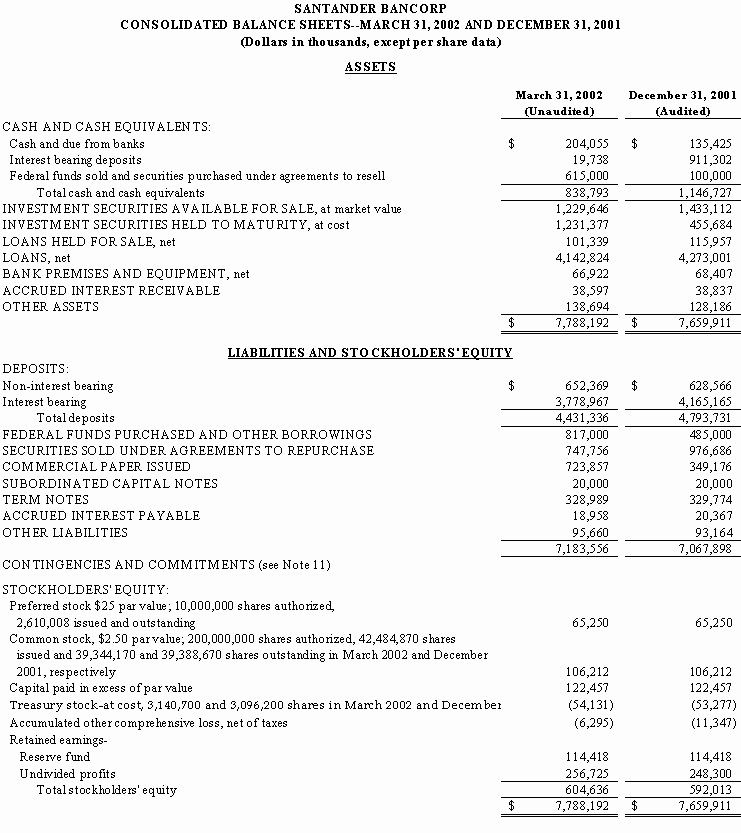
The accompanying notes are integral part of these consolidated balance sheets

The accompanying notes are an integral part of these consolidated statements
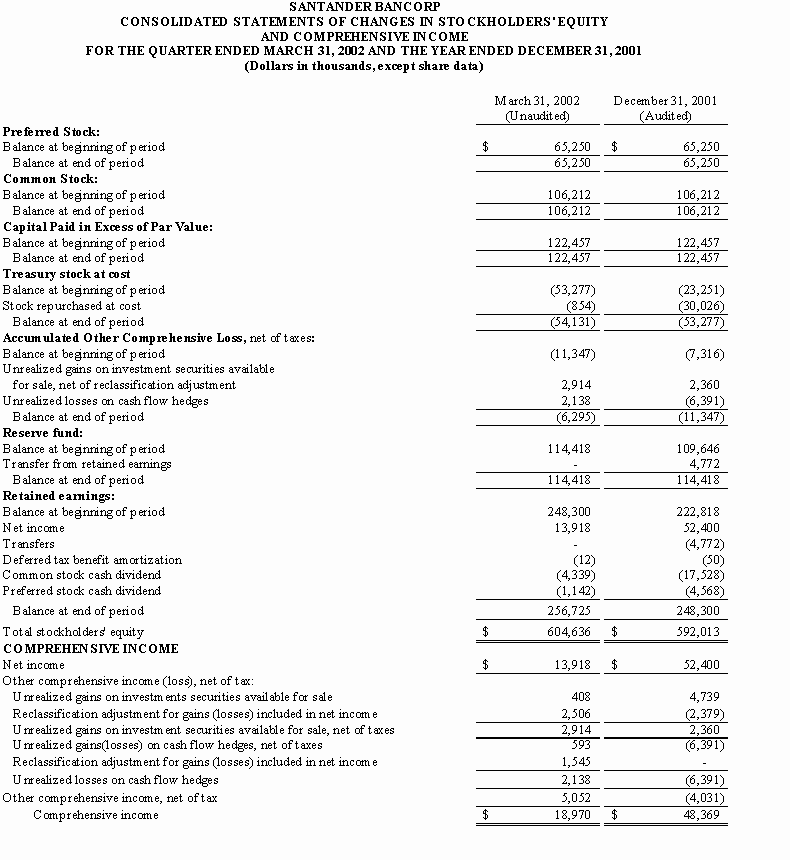
The accompanying notes are an integral part of these consolidated statements
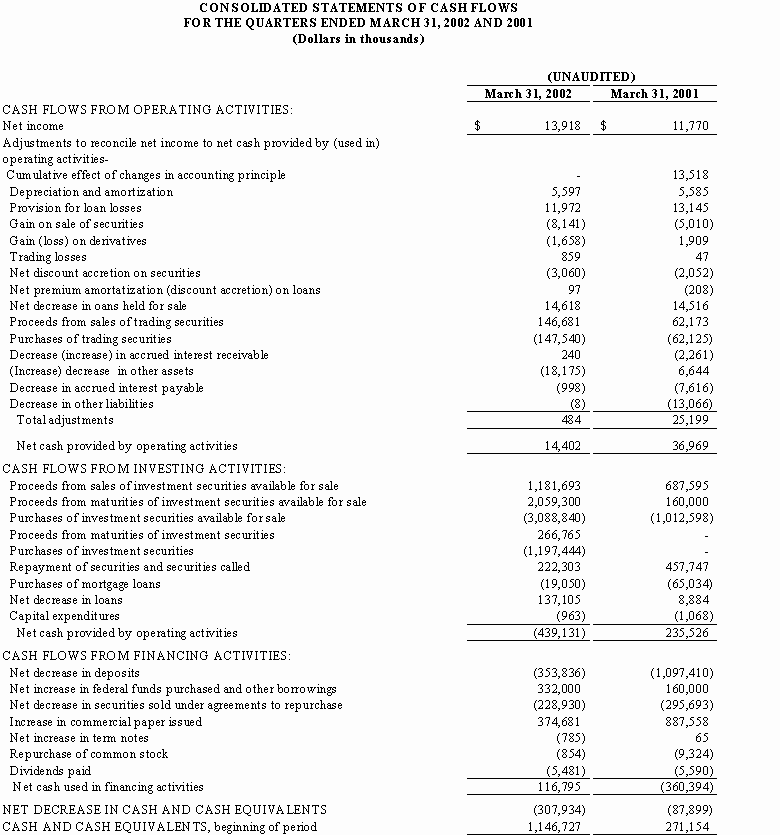
The accompanying notes are an integral part of these consolidated statements
SANTANDER BANCORP
NOTES TO CONSOLIDATED FINANCIAL STATEMENTS (UNAUDITED)
MARCH 31, 2002 AND 2001
- Summary of Significant Accounting Policies:
The accounting and reporting policies of Santander BanCorp (the Corporation), an 80.5% owned subsidiary of Santander Central Hispano, S.A. conform with accounting policies generally accepted in the United States and with general practices within the financial industry. The following is a summary of the most significant policies:
The interim consolidated financial statements included herein are unaudited, but reflect all adjustments, which, in the opinion of management, are necessary for a fair presentation of the consolidated financial condition, results of operations and cash flows for the interim periods presented. Adjustments included herein are of a normal recurring nature and include appropriate estimated provisions. The interim consolidated financial statements as of March 31, 2002 included herein have been prepared on a consistent basis with the year-end audited financial statements as of December 31, 2001.
Nature of Operations and Use of Estimates
The Corporation was reorganized on May 2nd, 2000 under the laws of the Commonwealth of Puerto Rico to serve as the bank holding company for Banco Santander Puerto Rico and Subsidiary (the "Bank") and other entities as management deemed appropriate. As a result of this reorganization each of the Bank´s outstanding shares of common stock was converted into one share of common stock of the new bank holding company. This reorganization was carried out pursuant to an Agreement and Plan of Merger by and between the Corporation and the Bank. Santander BanCorp is subject to the Federal Bank Holding Company Act and to the regulations, supervision, and examination of the Federal Reserve Board. The reorganization was treated as a tax-free reorganization and the exchange by the Bank´s shareholders of their shares of the Bank´s common stock for shares of Santander BanCorp common stock constituted a tax-free exchange for purposes of Puerto Rico income tax laws.
On September 26, 2000 the Corporation acquired 100% of the common stock of Inversiones y Desarrollos del Caribe, Inc. (INDECA) now doing business as Santander Insurance Agency, for the purpose of establishing an insurance agency. Santander Insurance Agency was approved by the Commissioner of Insurance of Puerto Rico to operate as an insurance and general agent, effective October 10, 2000.
The accounting and reporting policies of Santander BanCorp and its subsidiaries conform with generally accepted accounting principles and banking industry practices in the United States. The reorganizations were recorded at historical cost in a manner similar to a pooling of interests. Accordingly, at acquisition date, the Corporation recorded the assets acquired and liabilities assumed at book value and consolidated balance sheets, statements of income, changes in stockholders´ equity and comprehensive income and cash flows were presented as if the entities had been merged at the beginning of the year. All significant intercompany balances and transactions were eliminated.
In preparing the consolidated financial statements, management is required to make estimates and assumptions that affect the amounts reported in the consolidated financial statements and accompanying notes. Actual results could differ from those estimates.
Principles of Consolidation
The consolidated financial statements include the accounts of the Corporation, Santander Insurance Agency, the Bank and the Bank´s wholly owned subsidiaries, Santander Mortgage Corporation and Santander International Bank. All significant intercompany balances and transactions have been eliminated in consolidation.
Derivative Financial Instruments
The Corporation uses derivative financial instruments mostly as hedges of interest rate risk, changes in fair value of assets and liabilities and to secure future cash flows. Until December 31, 2000, gains and losses on these contracts were deferred and were reflected in income when the contracts were settled. Effective January 1, 2001, the Corporation accounts for its derivative instruments following the provisions of Statement of Accounting Standards No. 133 (SFAS No. 133), "Accounting for Derivative Instruments and Hedging Activities", as amended. The Corporation engages on a limited basis in derivative financial instruments for trading purposes.
Earnings Per Common Share
Basic and diluted earnings per common share are computed by dividing net income attributable to common stock, by the weighted average number of common shares outstanding during the period. The Corporation´s average number of common shares outstanding used in the computation of earnings per common share was 39,364,860 and 40,761,793 for the quarters ended March 31, 2002 and 2001, respectively. Basic and diluted earnings per share are the same since no stock options or other stock equivalents were outstanding during the periods ended March 31, 2002 and 2001.
Accounting for Derivative Instruments and Hedging Activities
During 1998, the Financial Accounting Standards Board (the Board) issued Statement of Financial Accounting Standards No. 133 (SFAS No. 133), "Accounting for Derivative Instruments and Hedging Activities". During 1999, the Board issued Statement of Financial Accounting Standards No. 137 (SFAS No. 137), "Accounting for Derivative Instruments and Hedging Activities-Deferral of the Effective Date of FASB Statement No. 133", which delays the effective date of SFAS No. 133 for one year. In addition, during 2000 the Board issued Statement of Financial Accounting Standards No. 138 (SFAS No. 138) "Accounting for Certain Derivative Instruments and Certain Hedging Activities - an Amendment of FASB Statement No. 133", which addressed a limited number of issues causing implementation difficulties for numerous entities that apply SFAS No. 133. SFAS No. 133, as amended establishes accounting and reporting standards for derivative instruments and hedging activities. It requires that an entity recognize all deriva tives as either assets or liabilities in the statement of financial position and measure those instruments at fair value. If certain conditions are met, a derivative may be specifically designated as (a) a hedge of the exposure to changes in fair value of a recognized asset or liability or an unrecognized firm commitment, (b) a hedge of the exposure to variable cash flows of a forecasted transaction, or (c) a hedge of the foreign currency exposure of a net investment in a foreign operation, an unrecognized firm commitment, an available-for-sale security, or a foreign-currency-denominated forecasted transaction. The accounting for changes in the fair value of a derivative depends on the intended use of the derivative and the resulting designation. SFAS No. 133, as amended by SFAS No. 137 and SFAS No. 138, is effective for all fiscal quarters of fiscal years beginning after June 15, 2000 and should not be applied retroactively to financial statements of prior periods. The Corporation applied SFAS No. 133, as a mended, on January 1, 2001. The transition adjustment for the year ended December 31, 2001 amounted to a loss of approximately $8,246,000 net of the effect of the related tax benefit of approximately $5,272,000 reported as a cumulative type adjustment in the statement of income and a loss of approximately $1,507,000 reported net of the effect of the related tax benefit of approximately $964,000 in other comprehensive income.
Other Accounting Pronouncements
The Financial Accounting Standards Board issued Statement of Financial Accounting Standards No. 142 (SFAS No. 142), "Goodwill and Other Intangible Assets" during June 2001. This statement addresses financial accounting and reporting for acquired goodwill and other intangible assets and supersedes APB Opinion No. 17, "Intangible Assets."
SFAS No. 142 addresses how intangible assets that are acquired individually or with a group of other assets (but not those acquired in a business combination) should be accounted for in financial statements upon their acquisition. This statement also addresses how goodwill and other intangible assets should be accounted for after they have been initially recognized in the financial statements. Under SFAS No. 142, goodwill and intangible assets that have indefinite useful lives will not be amortized but rather will be tested at least annually for impairment. Intangible assets with finite useful lives will continue to be amortized over their useful lives. This statement requires that goodwill be tested for impairment at least annually using a two-step process that begins with an estimation of the fair value of a reporting unit. The first step is a screen for potential impairment, and the second step measures the amount of impairment, if any. All intangible assets that are not amortized will be tested for im pairment at least annually by comparing the fair values of those assets with their recorded amounts. The provisions of this statement are required to be applied starting with fiscal years beginning after December 15, 2001. This statement is required to be applied at the beginning of the entity´s fiscal year and to be applied to all goodwill and other intangible assets recognized in its financial statements at that date. The Corporation applied SFAS No. 142 on January 1, 2002. The Corporation did not recognize any transition adjustment loss on the initial application of SFAS No. 142. Goodwill amortization for 2001 was approximately $1,197,000.
In June 2001, the Financial Accounting Standards Board issued SFAS No. 143, "Accounting for Asset Retirement Obligations." This Statement addresses the financial accounting and reporting for obligations associated with the retirement of tangible long-lived assets and the associated asset retirement costs. SFAS No. 143 requires that the fair value of a liability for an asset retirement obligation be recognized in the period in which it is incurred if a reasonable estimate of fair value can be made. The associated asset retirement costs are capitalized as part of the carrying amount of the long-lived asset. This Statement is effective for financial statements issued for fiscal years beginning after June 15, 2002. Currently, it is the opinion of management that the implementation of SFAS No. 143 is not expected to have a material impact on the Corporation´s consolidated results of operations or consolidated financial position.
In August 2001, the Financial Accounting Standards Board issued SFAS No. 144, "Accounting for the Impairment or Disposal of Long-Lived Assets." This Statement requires that one accounting model be used for long-lived assets to be disposed of by sale, whether previously held and used or newly acquired, and broadens the presentation of discontinued operations to include more disposal transactions. Under the provisions of this statement, for long-lived assets to be held and used an impairment loss will be recognized only if the carrying amount of the long-lived assets is not recoverable from its undiscounted cash flows and that impairment loss shall be measured as the difference between the carrying amount and fair value of the asset. SFAS No. 144 requires that long-lived assets to be abandoned, exchanged for a similar productive asset, or distributed to owners in a spinoff be considered held and used until disposed of. Long-lived assets to be disposed of by sale, whether previously held and used or newly ac quired, shall be recorded at the lower of its carrying amount or fair value less cost to sell and depreciation shall cease. The provisions of this Statement are effective for financial statements issued for fiscal years beginning after December 15, 2001, and interim periods within those fiscal years. Currently, it is the opinion of management that the implementation of SFAS No. 144 is not expected to have a material impact on the Corporation´s consolidated results of operations or consolidated financial position.
2. Investment Securities Available for Sale:
Investment securities available for sale and related contractual maturities:
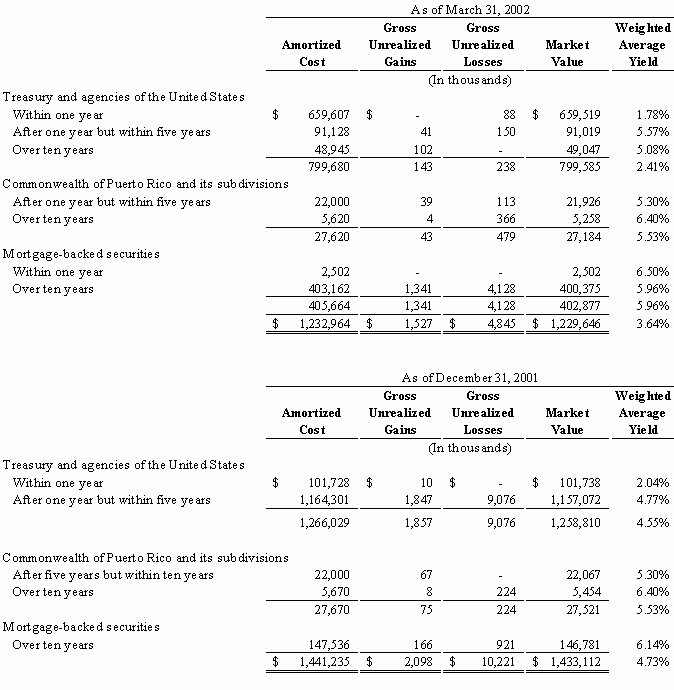 Contractual maturities on certain securities, including mortgage-backed securities could differ from actual maturities since certain issuers have the right to call or prepay these securities.
Contractual maturities on certain securities, including mortgage-backed securities could differ from actual maturities since certain issuers have the right to call or prepay these securities.
The weighted average yield on investment securities available for sale is based on amortized cost; therefore, it does not give effect to changes in fair value
3. Investment Securities Held to Maturity:
Investment securities and related contractual maturities:
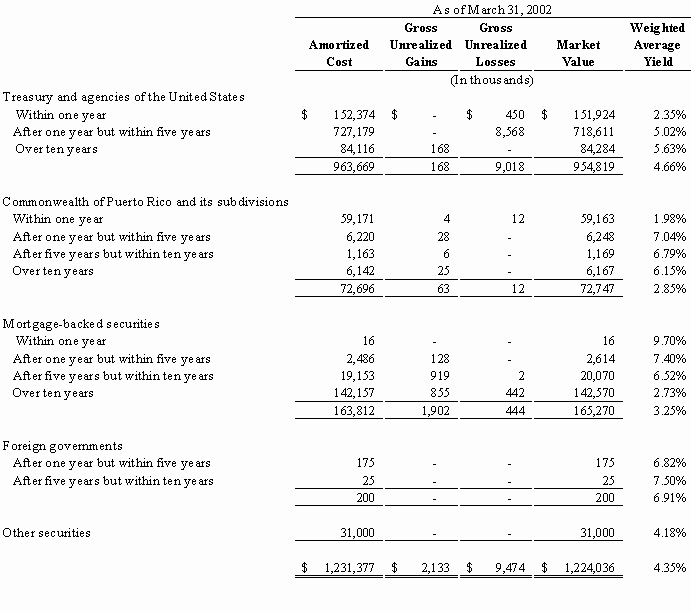
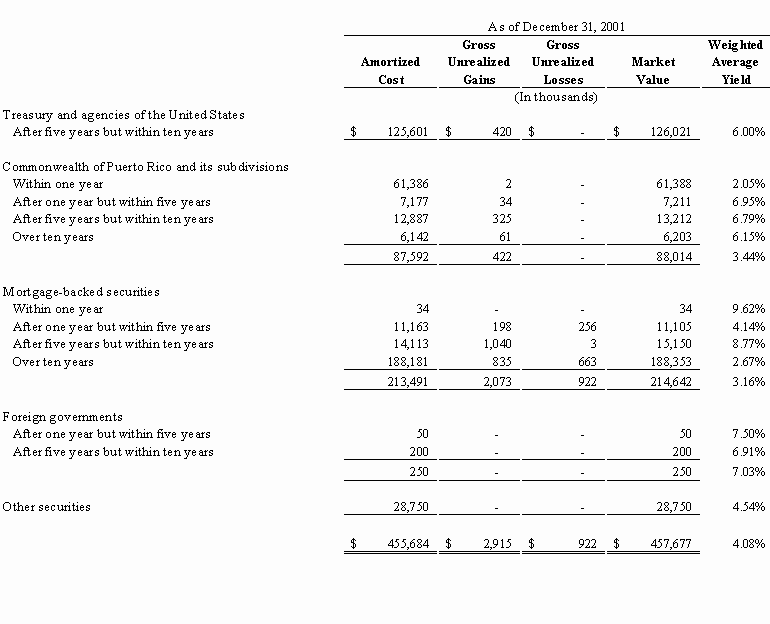
Contractual maturities on certain securities, including mortgage-backed securities could differ from actual maturities since some issuers have the right to call or prepay these securities.
The weighted average yield on investment securities is based on amortized cost; therefore, it does not give effect to changes in fair value.
4. Loans
The Corporation´s loan portfolio at March 31, 2002 and December 31, 2001 consists of the following:
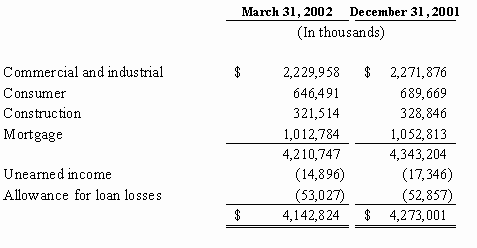
5. Allowance for Loan Losses:
Changes in the allowance for loan losses are summarized as follows:
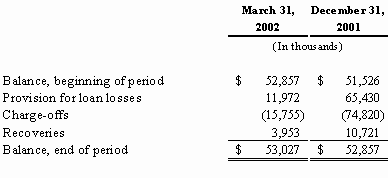
6. Other Assets:
Other assets consist of the following:

7. Short-Term Borrowings:
Following are summaries of short-term borrowings for the periods indicated, in thousands:


Federal funds purchased and other borrowings, repurchase agreements and commercial paper mature as follows:
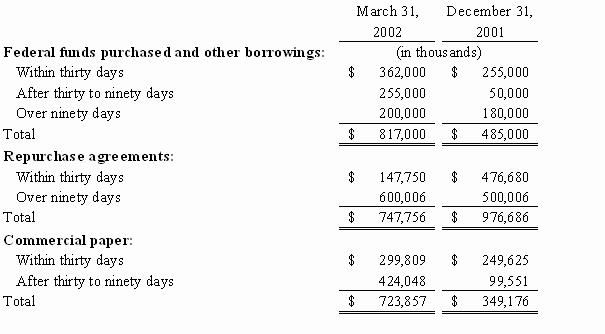
The following securities were sold under agreements to repurchase:


8. Stockholders´ Equity:
The Corporation has 10,000,000 shares of authorized preferred stock with a par value of $25, of which 2,610,008 were issued and outstanding at March 31, 2002 and December 31, 2001. The terms of the Series A Preferred Stock do not permit the payment of cash dividends on Common Stock if dividends on the Series A Preferred Stock are in arrears. The holders of the Series A Preferred Stock are entitled to receive noncumulative cash dividends when, as and if declared by the Board of Directors, out of the assets of the Corporation legally available therefor, at an annual rate of $1.75 per share of Series A Preferred Stock. The earnings per share computation excludes the dividends paid on preferred stock. The Corporation has continued to pay dividends on preferred stock at the rate of 7% annually.
The Series A Preferred Stock is not redeemable prior to July 1, 2003. On or after that date, the shares of Series A Preferred Stock will be redeemable in whole or in part from time to time at the option of the Corporation at the redemption prices set forth herein, subject to prior approval of the Federal Deposit Insurance Corporation and the Commissioner of Financial Institutions of Puerto Rico, plus accrued and unpaid dividends for the then current monthly dividend period to the date fixed for redemption.
During 2002 and 2001 the Corporation declared and paid quarterly cash dividends of $0.11 per share to its common shareholders.
On May 2nd, 2000, the Bank underwent a corporate reorganization wherein Santander BanCorp, a bank holding company was incorporated. As a result, shareholders of Banco Santander Puerto Rico became shareholders of Santander BanCorp and Banco Santander Puerto Rico became a wholly owned subsidiary of Santander BanCorp in a tax-free exchange for purposes of Puerto Rico income tax laws.
The Corporation adopted and implemented a Stock Repurchase Program in May 2000 and a second Program in December 2000. Under the Stock Repurchase Programs the Corporation acquired 3% of its then outstanding common shares. During June 2001, the Corporation started a third Stock Repurchase Program under which it plans to acquire 3% of its outstanding common shares. As of March 31, 2002, 3,140,700 shares amounting to $54,131,000 had been repurchased under the plans and are recorded at cost in the accompanying consolidated balance sheets.
The Corporation started a Dividend Reinvestment and Cash Purchase Plan in May 2000 under which holders of common stock have the opportunity to automatically invest cash dividends to purchase more shares of the Corporation. Shareholders may also make, as frequently as once a month, optional cash payments for investment in additional shares of common stock.
9. Derivative Financial Instruments:
The operations of the Corporation are subject to the risk of interest rate fluctuations to the extent that interest-earning assets (including securities) and interest-bearing liabilities mature or reprice at different times or in differing amounts. Risk management activities are aimed at optimizing net interest income, given levels of interest rate risk consistent with the Corporation´s business strategies. The Corporation has only limited involvement with derivative financial instruments and uses them mostly for hedging purposes.
Asset-liability risk management activities are conducted in the context of the Corporation´s liability sensitivity to interest rate changes. This liability sensitivity arises due to interest-bearing liabilities repricing more frequently than interest bearing assets. The opposite applies when rates are rising.
To achieve its risk management objectives, the Corporation uses a combination of derivative financial instruments, including interest rate swaps, caps, forward contracts and options. The Corporation is exposed to credit losses in the event of nonperformance by counterparties in certain derivative instruments. However, based on periodic assessment of counterparties´ credit worthiness, the Corporation does not anticipate nonperformance by such counterparties.
As of March 31, 2002, the Corporation had the following derivative financial instruments outstanding:
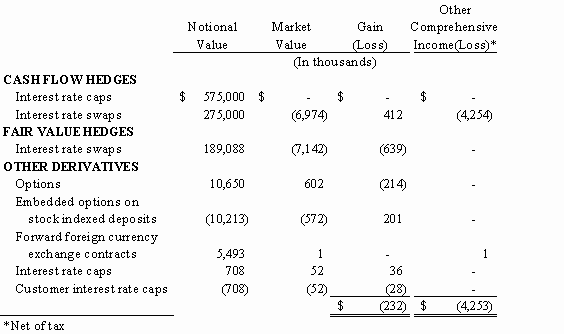
As of December 31, 2001, the Corporation had the following derivative financial instruments outstanding:
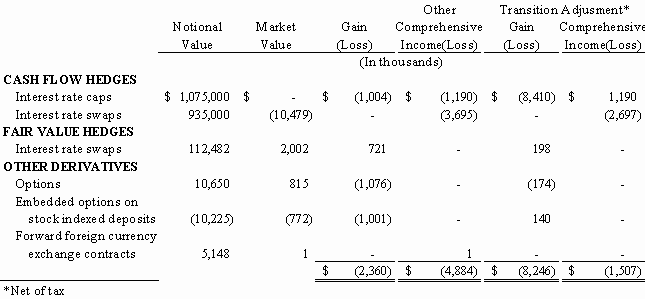
Interest rate caps are similar to option contracts that require the writer to pay the purchaser at specified future dates, the amount (if any) by which a specified market interest rate exceeds the fixed cap rate applied to a notional principal amount. The purchaser pays a premium for transferring the risk of unfavorable interest rate changes to the option writer. The Corporation´s principal objective in holding interest rate caps is the management of interest rate risk and to secure future cash flows, specifically to hedge the Corporation´s cost of funds, in the Commercial Paper Program and Repurchase Agreements, and to close the gap in a scenario of interest rates to the upside.
As of March 31, 2002, the Corporation had outstanding interest rate caps, with a notional value of $575,000,000, maturing through the year 2002. The caps are at a level of 6.50% against the one-month Libor. The premium paid on these transactions was approximately $27,746,000 and was being amortized on a monthly basis over the life of the caps until December 31, 2000. On January 1, 2001, pursuant to the implementation of SFAS No. 133, the Corporation recognized a transition adjustment loss on the write-off of the premium paid on caps of approximately $8,410,000 net of the effect of the related tax benefit of approximately $5,377,000 as a cumulative type adjustment in the consolidated statements of income. On that date, the Corporation also recorded a gain of approximately $1,190,000 net of the effect of the related tax cost of approximately $760,000 in other comprehensive income on the recognition of the intrinsic value of the caps derivative. As of March 31, 2002, the Corporation recognized no gain or loss related to that derivative.
Interest rate swaps involve the exchange of fixed and floating interest rate payments without an exchange of the underlying principal. Net interest settlements of interest rate swaps are recorded as an adjustment to interest income or interest expense of the hedged item.
The Corporation´s principal objective in holding interest rate swap agreements is the management of interest rate risk and changes in the fair value of assets and liabilities. The Corporation´s policy is that each swap contract be specifically tied to assets or liabilities with the objective of transforming the interest rate characteristic of the instrument. The Corporation swapped $100.0 million of term funds at a fixed spread over U.S. Treasury securities. These swaps were designated as cash flow hedges. The Corporation swapped $835.0 million during 2001and $40.0 million during 2002 to hedge the rollover of a series of fixed-rate short-term debt instruments these were designated as cash flow hedges. During 2002, $700 million of these cash flow hedges were cancelled due to the fact that the forecasted timing of rate increases did not occur within the time frame expected by management. A gain of $412,000 was recognized on the cancellation of these swaps.
As of March 31, 2002, the Corporation had outstanding interest rate swap agreements, with a notional amount of approximately $189,088,000, maturing through the year 2017. The weighted average rate paid and received on these contracts is 3.83% and 3.25%, respectively. As of March 31, 2002, the Corporation had retail certificates of deposit amounting to approximately $183.8 million swapped to create a floating rate source of funds and a $4.1 million variable rate loan were fixed at a spread over U.S. Treasury securities. These swaps were designated as fair value hedges. For the quarter ended March 31, 2002, the Corporation recognized a loss of approximately $639,000 on fair value hedges due to hedge ineffectiveness included in other gains and losses in the consolidated statements of income.
The Corporation issues certificates of deposit and IRA accounts with returns linked to the Standard and Poor´s 500 index which constitutes an embedded derivative instrument that must be bifurcated from the host deposit and recognized on the balance sheet in accordance with SFAS No. 133. The Corporation enters into option agreements in order to manage the interest rate risk on these deposits however, these options have not been designated for hedge accounting, therefore gains and losses on the market value of both the embedded derivative instruments and the option contracts are marked to market through earnings and recorded in other gains and losses on the consolidated statements of income. The Corporation recognized a transition adjustment gain of approximately $140,000 and a loss of approximately $174,000 on the embedded derivative instruments and the option contracts, respectively. For the quarter ended March 31, 2002, a gain of approximately $201,000 was recorded for the embedded derivative instr uments and a loss of approximately $214,000 was recorded on the option contracts.
Forwards are contracts for the delayed purchase of specified securities at a specified price and time. These contracts qualify for hedge accounting in accordance with SFAS No. 133. The Corporation occasionally enters into foreign currency exchange contracts in order to satisfy the needs of its customers, and at the same time enters into foreign currency exchange contracts with a related party under the same terms and conditions. As of March 31, 2002, the Corporation had foreign currency exchange contracts with a notional amount of $5,493,000 and recorded a gain of $1,455 net of the related tax liability of $568 in other comprehensive income (loss).
The Corporation occasionally enters into certain derivative transactions with customers. During 2002 the Corporation entered into interest rate caps with customers and simultaneously hedged the cap with an interest rate cap with a related party under the same terms and conditions. The Corporation recognized a net gain of $8,000 on this transaction.
10. Regulatory Matters:
The Corporation is subject to various regulatory capital requirements administered by the federal banking agencies. Failure to meet minimum capital requirements can initiate certain mandatory and possibly additional discretionary actions by regulators that, if undertaken, could have a direct material effect on the Corporation´s consolidated financial statements. The regulations require the Corporation to meet specific capital guidelines that involve quantitative measures of the Corporation´s assets, liabilities, and certain off-balance sheet items as calculated under regulatory accounting practices. The Corporation´s capital classification is also subject to qualitative judgements by the regulators about components, risk weightings, and other factors.
Quantitative measures established by regulation to ensure capital adequacy require the Corporation to maintain minimum amounts and ratios, as indicated below, of Total and Tier I capital (as defined) to risk-weighted assets (as defined), and of Tier I capital (as defined) to average assets (as defined). In management´s opinion, the Corporation met all capital adequacy requirements to which it was subject as of March 31, 2002.
As of March 31, 2002, the Corporation was well capitalized under the regulatory framework for prompt corrective action. To be categorized as well capitalized the Corporation must maintain a minimum total risk-based, Tier I capital and Tier I leverage ratio as set forth in the following table. In management´s opinion, there are no conditions or events since that notification that would have changed the institution´s category.
At March 31, 2002, required and actual regulatory capital amounts and ratios follow:

At December 31, 2001, required and actual regulatory capital amounts and ratios follow:

11. Contingencies and Commitments:
The Corporation is involved as plaintiff or defendant in a variety of routine litigation incidental to the normal course of business. Management believes, based on the opinion of legal counsel, that it has adequate defense or insurance protection with respect of such litigation and that any losses therefrom, whether or not insured, would not have a material adverse effect on the consolidated results of operations or consolidated financial position of the Corporation.
12. Segment Information:
Types of Products and Services
During 2001, the Corporation changed the structure of its internal organization which affected the composition of its reportable segments. Management´s focus has changed from a product-based approach to a client based focus. Segment information of prior years included herein has been restated to conform with current year presentation. The Corporation has three reportable segments: Retail Banking, Mortgage Banking, and Investments. Insurance operations and International Banking are other lines of business in which the Corporation commenced its involvement during 2000 and 2001, respectively. However, no separate disclosures are being provided on these operations, since they did not meet the quantitative thresholds for disclosure of segment information.
Through its Retail Banking, the Corporation provides a full range of financial products serving corporate, middle-market customers and individual customers as well as other market segments. This segment is composed of the Corporation´s branch network as well as certain specialized central units. This segment provides a full range of financial products such as deposits, commercial and consumer loans, electronic banking and others. This segment offers traditional banking services and has a specialized workforce to offer products and services tailored to the specific needs of the clients based on each client´s profile.
The Corporation engages in mortgage banking through the Bank´s subsidiary, Santander Mortgage Corporation. The Corporation´s mortgage banking business consists principally of the origination and acquisition of loans secured by residential mortgages. Through the activities of its Investments Department, the Corporation manages its assets and liabilities maximizing its net interest income, return on assets and return on equity while remaining within established parameters of interest rate and liquidity risks.
Measurement of Segment Profit or Loss and Segment Assets
The Corporation´s accounting policies for segments are the same as those described in the summary of significant accounting policies. Management evaluates segment performance based on segment profit or loss before income taxes. The Corporation accounts for inter-segment sales and transfers as if the sales or transfers were to third parties, that is, at current market prices.
Management Policy in Identifying Reportable Segments
The Corporation´s reportable business segments are strategic business units that offer distinctive products and services that are marketed through different channels. These are managed separately because of their unique technology, marketing and distribution requirements.
The following presents financial information of reportable segments for the periods ended March 31, 2002 and 2001. None of the following items have been added or deducted in the determination of operating segment profits: general corporate expenses and income taxes. The "Other" column includes the items necessary to reconcile the identified segments to the reported consolidated amounts.
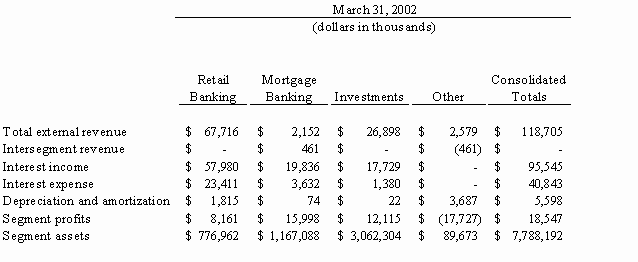

Reconciliation of Segment Information to Consolidated Amounts
Information for the Corporation´s reportable segments in relation to the consolidated totals follows:
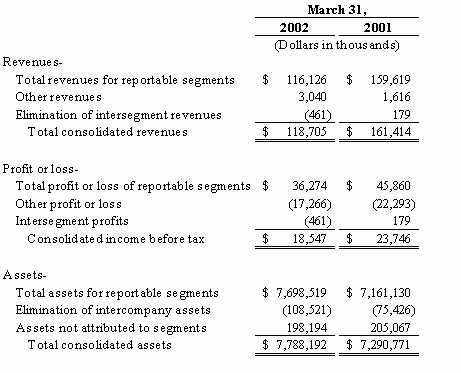
PART I – ITEM II
Management´s Discussion and Analysis of Financial Condition and
Results of Operations
SANTANDER BANCORP |
Selected Financial Data |
| | Quarter |
| | ended March 31, |
| (Dollars in thousands, except per share data) | 2002 | 2001 |
| CONDENSED INCOME STATEMENTS | | |
| Interest income | $ 95,545 | $ 142,631 |
| Interest expense | 40,843 | 81,299 |
| Net interest income | 54,702 | 61,332 |
| Security (losses) gains | 8,141 | 5,010 |
| Gain on sale of mortgage servicing rights | 123 | 118 |
| Other income | 14,896 | 13,655 |
| Operating expenses | 47,343 | 43,224 |
| Provision for loan losses | 11,972 | 13,145 |
| Income tax | 4,629 | 3,730 |
| Transition adjustment | - | (8,246) |
| Net income | $ 13,918 | $ 11,770 |
| PER PREFERRED SHARE DATA | | |
| Outstanding shares: | | |
| Average | 2,610,008 | 2,610,008 |
| End of period | 2,610,008 | 2,610,008 |
| Cash Dividend per Share | $ 0.44 | $ 0.44 |
| PER COMMON SHARE DATA* | | |
| Net income | $ 0.32 | $ 0.26 |
| Book value | $ 13.71 | $ 13.10 |
| Outstanding shares: | | |
| Average | 39,364,860 | 40,761,793 |
| End of period | 39,344,170 | 40,460,670 |
| Cash Dividend per Share | $ 0.11 | $ 0.11 |
| AVERAGE BALANCES | | |
| Net loans | 4,339,760 | 4,437,221 |
| Allowance for loan losses | 55,435 | 51,338 |
| Earning assets | 6,560,599 | 7,206,527 |
| Total assets | 6,883,423 | 7,557,847 |
| Deposits | 4,184,251 | 4,001,938 |
| Borrowings | 1,987,943 | 2,853,407 |
| Preferred equity | 65,250 | 65,250 |
| Common equity | 534,449 | 533,494 |
| PERIOD END BALANCES | | |
| Net loans | 4,244,163 | 4,466,575 |
| Allowance for loan losses | 53,027 | 47,970 |
| Earning assets | 7,543,979 | 7,060,103 |
| Total assets | 7,788,192 | 7,290,771 |
| Deposits | 4,431,336 | 3,829,199 |
| Borrowings | 2,637,602 | 2,764,902 |
| Preferred equity | 65,250 | 65,250 |
| Common equity | 539,386 | 530,167 |
| SELECTED RATIOS | | |
| Performance: | | |
| Net interest margin tax-equivalent basis | 3.57% | 3.82% |
| Efficiency ratio (1) | 65.08% | 52.97% |
| Return on average total assets (on an annualized basis) | 0.82% | 0.63% |
| ROA (annualized) before transition adjustment | 0.82% | 1.07% |
| Return on average common equity (on an annualized basis) | 9.69% | 8.08% |
| ROE (annualized) before transition adjustment | 9.69% | 14.35% |
| Average net loans/average total deposits | 103.72% | 110.88% |
| Average earning assets/average total assets | 95.31% | 95.35% |
| Average stockholders' equity/average assets | 8.71% | 7.92% |
| Fee income to average assets (annualized) | 0.61% | 0.52% |
| Capital: | | |
| Tier I capital to risk-adjusted assets | 11.56% | 11.18% |
| Total capital to risk-adjusted assets | 12.60% | 12.19% |
| Leverage Ratio | 8.56% | 7.65% |
| Asset quality: | | |
| Non-performing loans to total loans | 2.45% | 1.81% |
| Annualized net charge-offs to average loans | 1.09% | 1.51% |
| Allowance for loan losses to period-end loans | 1.23% | 1.06% |
| Allowance for loan losses to non-performing loans | 50.31% | 58.58% |
| Allowance for loan losses to non-performing loans plus | | |
| accruing loans past-due 90 days or more | 48.77% | 57.27% |
| Non-performing assets to total assets | 1.42% | 1.24% |
| Recoveries to charge-offs | 25.09% | 16.04% |
| *Per share data is based on the average number of shares outstanding during the periods. | |
| (1) Operating expenses divided by net interest income on a tax equivalent basis, plus other income excluding securities gains and losses | |
MANAGEMENT´S DISCUSSION AND ANALYSIS
OF FINANCIAL CONDITION AND RESULTS OF OPERATIONS
This financial discussion contains an analysis of the consolidated financial condition and consolidated results of operations of the Corporation and should be read in conjunction with the consolidated financial statements, notes and tables included elsewhere in this report.
Critical Accounting Policies
The consolidated financial statements of the Corporation are prepared in accordance with accounting principles generally accepted in the United States and with general practices within the financial industry. In preparing the consolidated financial statements, management is required to make estimates and assumptions that affect the reported amount of assets and liabilities and disclosure of contingent assets and liabilities at the date of the consolidated financial statements and the reported amount of revenues and expenses during the reporting period. Actual results could differ from those estimates. The Corporation believes that of its significant accounting policies detailed in Note 1 to the consolidated financial statements, the following may involve a higher degree of judgement and complexity.
Allowance for Loan Losses. The Corporation assesses the overall risks in its loan portfolio and establishes and maintains a reserve for probable losses thereon. The allowance for loan losses is maintained at a level sufficient to provide for estimated loan losses based on the evaluation of known and inherent risks in the Corporation´s loan portfolio. The Corporation´s management evaluates the adequacy of the allowance for loan losses on a monthly basis. Based on current and expected economic conditions, the expected level of net loan losses and the methodology established to evaluate the adequacy of the allowance for loan losses, management considers that the Corporation has established an adequate position in its allowance for loan losses. In determining the allowance, management considers the portfolio risk characteristics, prior loss experience, prevailing and projected economic conditions and loan impairment measurements. Any significant changes in these considerations would have an impact on the allowance for loan losses.
Financial Instruments. Certain financial instruments including derivatives, hedged items and investment securities available for sale are recorded at fair value and unrealized gains and losses are recorded in other comprehensive income or other gains and losses as appropriate. Fair values are based on listed market prices, if available. If listed market prices are not available, fair value is determined based on other relevant factors including price quotations for similar instruments. Fair value for certain derivative contracts are derived from pricing models that consider current market and contractual prices for the underlying financial instruments as well as time value and yield curve or volatility factors underlying the positions.
Income taxes. In preparing the consolidated financial statements the Corporation is required to estimate income taxes. This involves an estimation of current tax expense together with an assessment of temporary differences resulting from differences between the carrying amounts of assets and liabilities for financial reporting purposes and the amounts used for income tax purposes. The carrying value of the Corporation´s net deferred tax assets assumes that the Corporation will be able to generate sufficient future taxable income based on estimates and assumptions. If these estimates and related assumptions change in the future, the Corporation may be required to record valuation allowances against its deferred tax assets resulting in additional income tax expense in the consolidated statements of income. Management evaluates the realizability of the deferred tax assets on a quarterly basis and assesses the need for a valuation allowance. For the quarter ended March 31, 2002, the Corpor ation had no recorded valuation allowances related to its net deferred tax assets.
Impairment of long-lived assets, goodwill and other intangible assets. The Corporation´s long-lived assets include premises and equipment, goodwill and other intangible assets. Premises, equipment and intangible assets with finite useful lives are amortized over their estimated useful lives. Useful lives are based on management´s estimates of the period that the assets will generate revenue. If circumstances and conditions indicate deterioration in the value of tangible assets the book value would be adjusted and a loss would be recognized in current operations.
On January 1, 2002 the Corporation adopted Statement of Financial Accounting Standards No. 142, "Goodwill and Other Intangible Assets." Under SFAS No. 142, goodwill and intangible assets that have indefinite useful lives will not be amortized but rather will be tested at least annually for impairment by comparing the fair values of those assets with their recorded amounts. In assessing the recoverability of goodwill and other intangibles the Corporation must make assumptions regarding estimated future cash flows and other factors to determine the fair value of the respective assets. If these estimates or their related assumptions change in the future, the Corporation may be required to record impairment charges for these assets not previously recorded. The Corporation did not recognize any transition adjustment loss on the initial application of SFAS No. 142.
Pension and Other Postemployment Benefits.The determination of the Corporation´s obligation and expense for pension and other postretirement benefits is dependent on the selection of certain assumptions used by actuaries in calculating such amounts and include, among others, the discount rate, expected long-term rate of return on plan assets and rates of increase in compensation and healthcare costs. In accordance with generally accepted accounting principles, actual results that differ from the Corporation´s assumptions are accumulated and amortized over future periods and therefore, generally affect recognized expense and recorded obligation in such future periods. Management believes that the assumptions made are appropriate, however, significant differences in actual experience or significant changes in assumptions may materially affect pension and other postretirement obligations and future expense.
Results of Operations for the Quarter Ended March 31, 2002
Santander BanCorp is the bank holding company for Banco Santander Puerto Rico and Subsidiaries (the Bank).
Santander BanCorp (the Corporation) reported net income of $13.9 million for the first quarter of 2002, compared with $11.8 million for the same period in 2001. Earnings per common share (EPS) for the first quarter of 2002 were $0.32, based on 39,364,860 average shares outstanding. For the first quarter of 2001 the Corporation reported net income of $11.8 million after the effect of the net transition adjustment recognized pursuant to the implementation of Statement of Accounting Standards No. 133 (SFAS No. 133), "Accounting for Derivative Instruments and Hedging Activities", as amended. Before the transition adjustment, net income for the first quarter of 2001 reached $20.0 million. Earnings per common share for the first quarter of 2001 were $0.26, and $0.46 before the transition adjustment, based on 40,761,793 average shares outstanding. Return on average total assets (ROA) on an annualized basis and return on average common equity (ROE) on an annualized basis for the quarter ended March 31, 2002 w ere 0.82% and 9.69%, respectively, compared with 0.63% and 8.08% reported during the first quarter of 2001. Before giving consideration to the transition adjustment ROA and ROE for the first quarter of 2001 were 1.07% and 14.35%, respectively.
Net Interest Income
The Corporation´s net interest income decreased 10.8% to $54.7 million for the quarter ended March 31, 2002 from $61.3 million for the quarter ended March 31, 2001. The decrease in the quarter´s net interest income was due to a 9% reduction in average interest earning assets, as well as a decrease in the yield of those assets of approximately 230 basis points. There was a significant reduction in average investment securities of $0.8 billion during the first quarter of the year compared to the same period in 2001. There was also a reduction in average net loans of $97 million in 2002 compared to the same period in 2001. These decreases were partially offset by an increase in average interest bearing deposits of $300.8 million during the first quarter of 2002 compared to the same period in 2001. Average interest bearing liabilities also reflected a decrease of 11.5% to $5.5 billion in 2002 from $6.3 billion in 2001. The most significant decrease in average interest bearing liabilities was in borrowings.
To permit the comparison of assets with different tax attributes, the interest income on tax-exempt assets under this heading has been adjusted by an amount equal to the income taxes which would have been paid had the income been fully taxable. This tax equivalent adjustment is derived using the applicable statutory tax rate and resulted in an adjustment of $3.0 million and $6.5 million for the quarters ended March 31, 2002 and 2001, respectively.
The net interest margin on a tax-equivalent basis decreased from 3.82% for the quarter ended March 31, 2001 to 3.57% for the quarter ended March 31, 2002. This decrease was primarily due to a decrease in the yield on earning assets as well as a decrease in earning assets. These decreases were partially offset by decreases in the cost of funds and in the cost of funding earning assets (due to decreases in the prime rate) and a decrease in the average balance of interest bearing liabilities.
The table on page 34, Quarterly Average Balance Sheet and Summary of Net Interest Income, presents average balance sheets, net interest income on a tax equivalent basis and interest rates for the first quarters of 2002 and 2001. The table on Interest Variance Analysis on a Tax Equivalent Basis on page 26, allocates changes in the Corporation´s interest income (on a tax-equivalent basis) and interest expense between changes in the average volume of interest earning assets and interest bearing liabilities and changes in their respective interest rates for the first quarter of 2002 compared with the first quarter of 2001. Volume and rate variances have been calculated based on the activity in average balances over the period and changes in interest rates on average interest earning assets and average interest bearing liabilities.
Interest Income
The Corporation´s interest income on a tax equivalent basis decreased $50.6 million, or 33.9% to $98.6 million for the quarter ended March 31, 2002 from $149.1 million for the quarter ended March 31, 2001. This decrease was attributed to a decrease of $14.4 million in the volume of the Corporation´s interest earning assets, together with a decrease in the yield of these assets of $36.2 million. These decreases were only partially offset by decreases in the volume of average interest bearing liabilities of $9.8 million and in the cost of those liabilities of $30.7 million.
Average interest earning assets decreased to $6.6 billion for the quarter ended March 31, 2001, compared with $7.2 billion for the same quarter in 2001, due primarily to a reduction in the average investment securities portfolio. Average investment securities decreased 31.8% from $2.7 billion in March 2001 to $1.8 billion during the same quarter in 2002.
The average volume of loans also reflected a decrease of $97 million for the quarter ended March 31, 2002 compared with the same period in 2001. The decrease in average loans was due primarily to decreases in average construction and consumer loans of $71.9 million and $122.5 million respectively, for the quarter ended March 31, 2002 compared to the same period in 2001. These decreases were partially offset by increases in average mortgage loans of $182.1 million for the same periods.
The average yield on earning assets decreased from 8.39% for the quarter ended March 31, 2001 to 6.09% for the quarter ended March 31, 2002. This decrease was due both to the decrease in average interest rates and in average loan balances.
Interest Expense
The Corporation´s average interest bearing liabilities decreased $719 million from $6.3 billion for the quarter ended March 31, 2001, to $5.5 billion for the quarter ended March 31, 2002. Average borrowings reflected a significant decrease of $760 million from $2.4 billion in March 2001 to $1.6 billion in March 2002. There was also a decrease in average time deposits of $100 million that was offset by an increase in savings and NOW accounts of $246 million during the first quarter of 2002 compared to the same period in 2001. The reduction in higher cost borrowings had a favorable impact on the Corporation´s results of operations during 2002.
Interest expense decreased 49.8% to $40.8 million for the quarter ended March 31, 2002 from $81.3 million for the quarter ended March 31, 2001. The decrease in interest expense was attributed to a $9.8 million decrease in the volume of interest bearing liabilities and a $30.7 million decrease in cost of funds.
There was an increase in the volume of average deposits during the first quarter of 2002 compared to the same period in 2001. The average cost of interest bearing liabilities also reflected a significant decrease of 227 basis points to 2.99% for the three-month period ended March 31, 2002 compared to 5.26% for the same period in 2001. This decrease is a direct result of the reductions in prime rate throughout 2001.
The following table allocates changes in the Corporation´s interest income, on a tax-equivalent basis, and interest expense between changes in the average volume of interest earning assets and interest bearing liabilities, and changes in their respective interest rates, for the three months ended March 31, 2002 compared to the three months ended March 31, 2001. Volume and rate variances have been calculated based on the activity in average balances over the period and changes in interest rates on average interest earning assets and average interest bearing liabilities. The changes that are not due solely to volume or rate are allocated to volume and rate based on the proportion of change in each category.
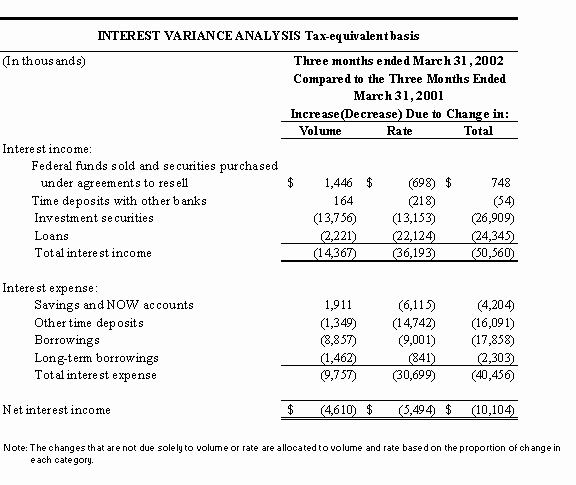
Provision for Loan Losses
The Corporation assesses the overall risks in its loan portfolio and establishes and maintains an allowance for possible losses thereon. The allowance for loan losses is maintained at a level sufficient to provide for estimated loan losses based on the evaluation of known and inherent risks in the Corporation´s loan portfolio. The Corporation´s management evaluates the adequacy of the allowance for loan losses on a monthly basis. In determining the allowance, management considers the portfolio risk characteristics, prior loss experience, prevailing and projected economic conditions and loan impairment measurements. Based on current and expected economic conditions, the expected level of net loan losses and the methodology established to evaluate the adequacy of the allowance for loan losses, management considers that the Corporation has established an adequate position in its allowance for loan losses. The following table sets forth an analysis of the activity in the allow ance for possible loan losses during the periods indicated:
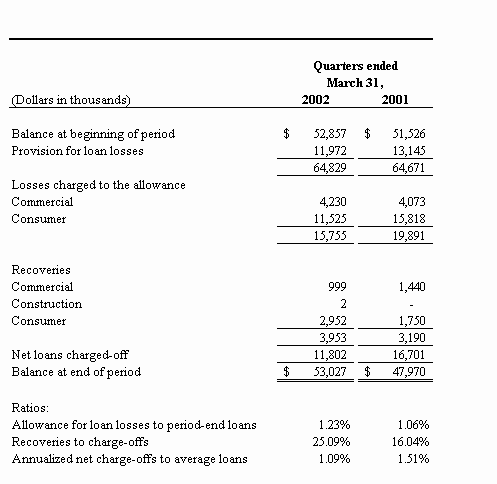
For the quarter ended March 31, 2002, the provision for loan losses was $12.0 million compared to $13.1 million for the same quarter in 2001. This decrease in the provision was due to the decrease in net charge offs of $4.9 million during the first quarter of 2002 as well as to the decrease in average loans during the period.
The allowance for loan losses stands at 1.23% of total loans as of March 31, 2002 an increase from 1.06% as of March 31, 2001. This allowance represents 50.31% of total non-performing loans, and when real estate collateral is considered this ratio reaches 120.3%. The annualized ratio of net charge-offs to average loans for the quarter ended March 31, 2002 decreased to 1.09% from 1.51% for the same period ended March 31, 2001.
Other Income
Other income consists of service charges on the Corporation´s deposit accounts, other service fees, including mortgage servicing fees and fees on credit cards, gains and losses on sales of securities and certain other gains and losses and other income.
The following table sets forth the components of the Corporation´s other income for the quarters ended March 31, 2002 and 2001.
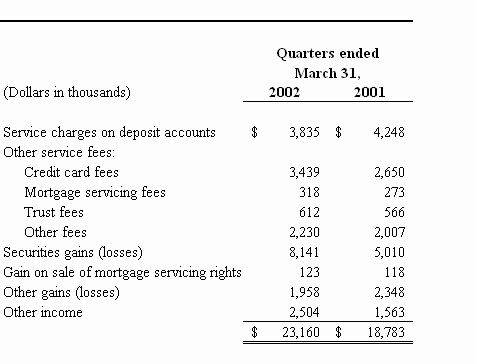
The Corporation´s other income reflected an increase of $4.4 million or 23.3% for the quarter ended March 31, 2002 compared to the quarter ended March 31, 2001. This increase in other income was due to a securities gain of $8.1 million, an increase of $3.1 million over the gain recognized during the first quarter of 2001. Other service fees increased during the quarter ended March 31, 2002 due primarily to increases in credit card fees. Service fees on deposit accounts decreased as a result of the decrease in average overdrafts. These decreases were partially offset by increases in credit card, mortgage servicing, trust and other fees. The increase in credit card fees was due to operational changes in the processing of the portfolio that is now handled internally, thereby leading to a recognition of gross fees. First quarter gains were partially offset by lower gains on sales of mortgage loans and mortgage servicing rights retained during 2002 compared to 2001. There was also a lower loss recorded on valuation of derivative instruments of $0.2 million for the quarter compared to $2.0 million for the first quarter of 2001. The increase in other income is due to higher insurance commissions during 2002 and higher technical assistance fees to affiliates and increases in rentals of point of sale terminals.
Operating Expenses
The following table presents the detail of other operating expenses for the periods indicated:

For the quarter ended March 31, 2002, the Corporation´s efficiency ratio on a tax equivalent basis reached a level of 65.08% compared to 52.97% for the same period in 2001, mainly as a result of a decrease in net interest income on a tax equivalent basis coupled with an increase in operating expenses.
For the quarter ended March 31, 2002 total operating expenses reflected an increase of $4.1 million or 9.5% compared to the same period in 2001. Personnel costs reflected an increase of $1.6 million for the quarter ended March 31, 2002 compared to the same period in 2001. This increase was due to an increase in personnel of approximately 277 employees, increase in salaries of approximately 3.5% and increases in overtime and temporary help due to special projects related to systems conversions.
Other operating expenses reflected an increase of $2.5 million during the quarter ended March 31, 2002. This increase was due to an increase in "All Other Expenses" as a result of lower deferral of loan origination costs of $1.6 million, higher software amortization of $0.5 million, higher insurance costs of $0.3 million and higher commissions on loans and credit card expenses of $0.3 million each. These increases were partially offset by decreases in occupancy expense, communications, advertising and amortization of intangibles as a result of implementation of SFAS No. 142.
Provision for Income Tax
The provision for income tax amounted to $4.6 million (or 25.0% of pretax earnings) for the quarter ended March 31, 2002 compared to $3.7 million (or 15.7% of pretax earnings) for the same period in 2001. The increase in income tax expense is due lower exempt income in 2002 and to the recognition of certain nonrecurring tax benefits in 2001. The difference between the Corporation´s statutory and effective tax rates is due primarily to the benefits of net tax-exempt interest income.
FINANCIAL CONDITION – MARCH 31, 2002
Assets
The Corporation´s assets reached $7.8 billion as of March 31, 2002, a 1.7% increase compared to total assets of $7.7 billion at December 31, 2001. This increase was a result of an increase in the investment portfolio of $572 million during the quarter due to the Corporation´s effort to increase the portfolio that was partially called during 2001. There was also a decrease of $307.9 million in cash and cash equivalents and in net loans of $144.8 million during the first quarter of the year.
The composition of the loan portfolio was as follows:
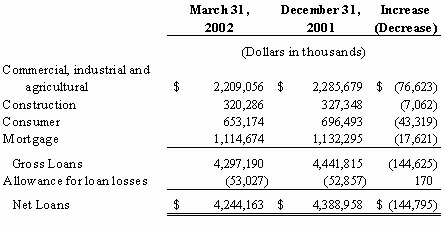
Net loans at March 31, 2002 were $4.2 billion, reflecting a decrease in the loan portfolio of $145 million compared to $4.4 million at December 31, 2001.
The Corporation´s average loan portfolio for the first quarter of 2002 compared to the first quarter of 2001 reflects a decrease of $97.5 million. The downward trend in the Corporation´s lending activity and the Corporation´s strategic decision to withdraw from the auto-lending sector was partially offset by increases in the average mortgage loan portfolio of $182.1 million.
Non-performing Assets and Past Due Loans
As of March 31, 2002, the Corporation´s total non-performing assets increased to $110.4 million or 2.6% of total loans from $100.0 million or 2.3% of total loans as of December 31, 2001. The increase in non-performing assets was reflected primarily in the commercial and mortgage loan portfolios. Non-performing loans (excluding other real estate owned) at March 31, 2002 increased to $105.4 million or 2.5% of total loans from $95.2 million or 2.1% of total loans at December 31, 2001. Repossessed assets increased $0.2 million during the first quarter of 2002. Accruing loans past-due 90 days or more registered a decrease of $2.2 million from $5.5 million at December 31, 2001. The level of non-performing loans to total loans stands at 2.45% compared to 2.14% experienced at year-end 2001. As of March 31,2002 the coverage ratio (allowance for loan losses to total non-performing loans) reached 50.31%, when real estate collateral is considered, this ratio reflects a coverage of 120.3%. The C orporation continuously monitors non-performing assets and has provided additional resources to manage the non-performing loan portfolio.
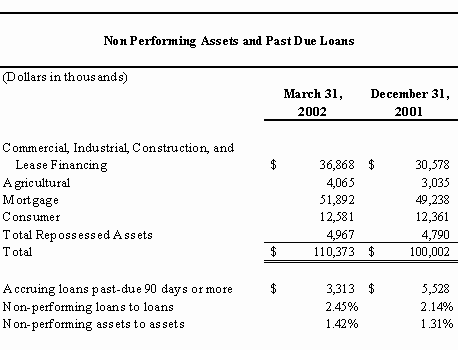
Allowance for Loan Losses
The Corporation´s allowance for loan losses was $53.0 million, or 1.23% of loans, at March 31, 2002 compared to $52.9 million, or 1.19% of loans at year-end 2001. The coverage ratio (allowance for loan losses to non-performing loans) equaled 50.31% at the end of the first quarter of 2002, down from 55.52% at December 31, 2001, due to higher non-performing assets. Net charge-offs of $11.8 million for the quarter were offset by a provision of $12.0 million. Although the Corporation´s provision and allowance for loan losses will fluctuate from time to time based on economic conditions, net charge-off levels, and changes in the level and mix of the loan portfolio, management considers that the Corporation has established an adequate position in its allowance for loan losses.
Liabilities
As of March 31, 2002, total liabilities reached $7.2 billion, an increase of $116 million over year-end balances. The increase in liabilities was due to increases in federal funds purchased and other borrowings of $332 million and in commercial paper issued of $375 million that were partially offset by decreases in deposits of $362 million and in securities sold under agreements to repurchase of $229 million.
Deposits
At March 31, 2002, total deposits were $4.4 billion, reflecting ad decrease of $362 million or 7.6% from $4.8 billion at December 31, 2001. Average deposits for the quarter ended March 31, 2002 were $4.2 billion, an increase of 4.6% from the same period in 2001. The Corporation continues its efforts to increase its deposit base by implementing a direct marketing campaign to maximize the cross selling of products and services by the segmentation of its client base and the extensive use of alternative marketing tools such as telephone and internet banking.
Capital and Dividends
Stockholders´ equity was $605 million or 7.8% of total assets at March 31, 2002, compared to $592 million or 7.7% of total assets at December 31, 2001. The increase in stockholder´s equity was due to the net income generated during the quarter ended March 31, 2002 and improvement in the valuation of securities available for sale and cash flow hedges. This increase was partially offset by the treasury stock acquired during the quarter, cash dividends paid on common and preferred stock during the year.
The Corporation declared cash dividends of $0.11 per common share to all stockholders of record as of March 8, 2002 and expects to continue to pay quarterly dividends.
The Corporation is subject to various regulatory capital requirements administered by the federal banking agencies. Failure to meet minimum capital requirements can initiate certain mandatory and possibly additional discretionary actions by regulators that, if undertaken, could have a direct material effect on the Corporation´s consolidated financial statements. The regulations require the Corporation to meet specific capital guidelines that involve quantitative measures of the Corporation´s assets, liabilities, and certain off-balance sheet items as calculated under regulatory accounting practices. The Corporation´s capital classification is also subject to qualitative judgements by the regulators about components, risk weightings, and other factors.
As of March 31, 2002, the Corporation was well capitalized under the regulatory framework for prompt corrective action. At March 31, 2002 the Corporation continues to exceed the regulatory risk-based capital requirements for well-capitalized institutions. Tier I capital to risk-adjusted assets and total capital ratios at March 31, 2002 were 11.56% and 12.60%, respectively and the leverage ratio was 8.56%.
Santander BanCorp was incorporated under the laws of the Commonwealth of Puerto Rico and is an 82.1% directly and indirectly owned subsidiary of Banco Santander Central Hispano, S.A. (BSCH). Santander BanCorp was created for the purpose of effecting a corporate reorganization and to serve as a bank holding company. Santander BanCorp now serves as the bank holding company for Banco Santander Puerto Rico and Subsidiaries (the Bank)..
On September 26, 2000 the Corporation acquired 100% of the common stock of Inversiones y Desarrollos del Caribe, Inc. (INDECA) now doing business as Santander Insurance Agency, for the purpose of establishing an insurance agency. Santander Insurance Agency has been approved by the Commissioner of Insurance of Puerto Rico to operate as an Insurance and General Agent, effective October 10, 2000.
The Corporation adopted and implemented a Stock Repurchase Program in May 2000 and a second Program in December 2000. Under the Stock Repurchase Programs the Corporation acquired 3% of its then outstanding common shares. During June 2001, the Corporation started a third Stock Repurchase Program under which it plans to acquire 3% of its outstanding common shares. As of March 31, 2002, 3,140,700 shares amounting to $54,131,000 had been repurchased under the plans. With the Dividend Reinvestment and Cash Purchase Plans holders of common stock have the opportunity to automatically invest cash dividends to purchase more shares of the Corporation. Shareholders may also make, as frequently as once a month, optional cash payments for investment in additional shares of common stock.
Liquidity
The Corporation´s general policy is to maintain liquidity adequate to ensure its ability to honor withdrawals of deposits, make repayments at maturity of other liabilities, extend loans and meet its own working capital needs. Liquidity is derived from the Corporation´s capital, reserves, and securities portfolio. The Corporation has established lines of credit with foreign and domestic banks, has access to U.S. markets through its commercial paper program, and also has broadened its relations in the federal funds and repurchase agreement markets to increase the availability of other sources of funds and to augment liquidity as necessary.
Management monitors liquidity levels each month. The focus is on the liquidity ratio, which presents total liquid assets over net volatile liabilities and core deposits. The Corporation believes it has sufficient liquidity to meet current obligations.
SANTANDER BANCORP |
QUARTER TO DATE AVERAGE BALANCE SHEET AND SUMMARY OF NET INTEREST INCOME |
Tax Equivalent Basis |
(Dollars in thousands) | March 31, 2002 | | | March 31, 2001 | | |
| Average | | Average | Average | | Average |
| Balance | Interest | Rate | Balance | Interest | Rate |
Interest bearing deposits | $ 85,601 | $ 274 | 1.30% | $ 49,986 | $ 328 | 2.66% |
Federal funds sold and securities purchased | | | | | | |
under agreements to resell | 312,433 | 1,395 | 1.81% | 47,245 | 647 | 5.55% |
Total interest bearing deposits | 398,034 | 1,669 | 1.70% | 97,231 | 975 | 4.07% |
U.S.Treasury securities | 515,926 | 2,266 | 1.78% | 178,794 | 2,756 | 6.25% |
Obligations of other U.S.government | | | | | | |
agencies and corporations | 791,123 | 9,317 | 4.78% | 1,842,821 | 31,285 | 6.88% |
Obligations of government of Puerto Rico | | | | | | |
and political subdivisions | 24,984 | 723 | 11.74% | 27,799 | 567 | 8.27% |
Collateralized mortgage obligations and | | | | | | |
mortgage backed securities | 419,568 | 4,890 | 4.73% | 542,773 | 8,789 | 6.57% |
Other | 71,204 | 855 | 4.87% | 79,888 | 1,563 | 7.93% |
Total investment securities | 1,822,805 | 18,051 | 4.02% | 2,672,075 | 44,960 | 6.82% |
Loans (net of unearned income) | 4,339,760 | 78,854 | 7.37% | 4,437,221 | 103,199 | 9.43% |
Total interest earning assets/ interest income | 6,560,599 | 98,574 | 6.09% | 7,206,527 | 149,134 | 8.39% |
Total non-interest earning assests | 322,824 | | | 351,320 | | |
Total assets | $ 6,883,423 | $ 98,574 | | $ 7,557,847 | $ 149,134 | |
| | | | | | |
Savings and NOW accounts | $ 1,608,438 | $ 7,937 | 2.00% | $ 1,362,352 | $ 12,141 | 3.61% |
Other time deposits | 1,948,439 | 12,906 | 2.69% | 2,048,191 | 28,997 | 5.74% |
Borrowings | 1,638,591 | 15,397 | 3.81% | 2,398,989 | 33,255 | 5.62% |
Term Notes | 329,352 | 4,378 | 5.39% | 434,418 | 6,616 | 6.18% |
Subordinated Notes | 20,000 | 225 | 4.56% | 20,000 | 290 | 5.88% |
Total interest bearing liabilities/interest expense | 5,544,820 | 40,843 | 2.99% | 6,263,950 | 81,299 | 5.26% |
Total non-interest bearing liabilities | 738,904 | | | 695,153 | | |
Total liabilities | 6,283,724 | | | 6,959,103 | | |
Stockholders' Equity | 599,699 | | | 598,744 | | |
Total liabilities and stockholders' equity | $ 6,883,423 | | | $ 7,557,847 | | |
Net interest income | | $ 57,731 | | | $ 67,835 | |
Cost of funding earning assets | | | 2.52% | | | 4.58% |
Net interest margin | | | 3.57% | | | 3.82% |
PART I – ITEM III
QUALITATIVE AND QUANTITATIVE DISCLOSURES OF MARKET RISK
QUALITATIVE AND QUANTITATIVE DISCLOSURE OF MARKET RISK
Asset and Liability Management
The Corporation´s policy with respect to asset liability management is to maximize its net interest income, return on assets and return on equity while remaining within the established parameters of interest rate and liquidity risks provided by the Board of Directors and the relevant regulatory authorities. Subject to these constraints, the Corporation takes mismatched interest rate positions. The Corporation´s asset and liability management policies are developed and implemented by its Asset and Liability Committee ("ALCO"), which is composed of senior members of the Corporation including the President, Chief Financial Officer, Treasurer and other executive officers of the Corporation. In addition, the Corporation´s Chief Accounting Officer reports monthly to the ALCO on the status of all open positions of the Corporation. The ALCO reports on a monthly basis to the member´s of the Bank´s Board of Directors.
Market Risk and Interest Rate Sensitivity
A key component of the Corporation´s asset and liability policy is the management of interest rate sensitivity. Interest rate sensitivity is the relationship between market interest rates and net interest income due to the maturity or repricing characteristics of interest earning assets and interest bearing liabilities. For any given period, the pricing structure is matched when an equal amount of such assets and liabilities mature or reprice in that period. Any mismatch of interest earning assets and interest bearing liabilities is known as a gap position. A positive gap denotes asset sensitivity, which means that an increase in interest rates would have a positive effect on net interest income, while a decrease in interest rates would have a negative effect on net interest income. The Corporation typically experiences a negative gap, which denotes liability sensitivity and means that an increase in interest rates would have a negative effect on net interest income while a decrease in interest rates would have a positive effect on net interest income.
The Corporation´s interest rate sensitivity strategy takes into account not only rates of return and the underlying degree of risk, but also liquidity requirements, capital costs and additional demand for funds. The Corporation´s maturity mismatches and positions are monitored by the ALCO and managed within limits established by the Board of Directors.
The following table sets forth the repricing of the Corporation´s interest earning assets and interest bearing liabilities at March 31, 2002 and may not be representative of interest rate gap positions at other times. In addition, variations in interest rate sensitivity may exist within the repricing period presented due to the differing repricing dates within the period.
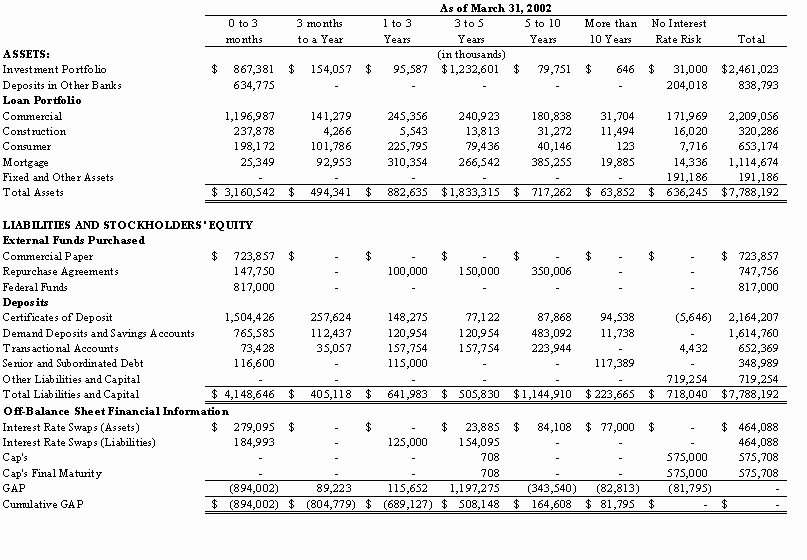
Interest rate risk is the primary market risk to which the Corporation is exposed. Nearly all of the Corporation´s interest rate risk arises from instruments, positions and transactions entered into for purposes other than trading. They include loans, investment securities, deposits, short-term borrowings, senior and subordinated debt and derivative financial instruments used for asset and liability management.
As part of its interest rate risk management process, the Corporation analyzes on an ongoing basis how profitable the balance sheet structure is and how this structure will react under different market scenarios. In order to carry out this task, management prepares two standardized reports with detailed information on the sources of interest income and expense: the "Financial Profitability Report", and the "Net Interest Income Shock Report." The former deals with historical data while the latter deals with expected future earnings.
The Financial Profitability Report identifies individual components of the Corporation´s non-trading portfolio independently with their corresponding interest income or expense. It uses the historical information at the end of each month to track the yield of such components and to calculate net interest income for such time period.
The Net Interest Income Shock Report uses a simulation analysis to measure the amount of net interest income the Corporation would have from its operations throughout the next twelve months and the sensitivity of these earnings to assumed shifts in market interest rates throughout the same period. The important assumptions of this analysis are: ( i ) rate shifts are parallel and immediate throughout the yield curve; (ii) rate changes affect all assets and liabilities equally; (iii) interest bearing demand accounts and savings passbooks will only partially run off in a period of one year; and (iv) demand deposit accounts will run off in a period of ten years. Cash flows from assets and liabilities are assumed to be reinvested at market rates in similar instruments. The object is to simulate a dynamic gap analysis enabling a more accurate interest rate risk assessment.
Risk management policy and procedures establish a risk tolerance loss limit of 5.0% for net interest income in a scenario of a 100 basis point (1.0%) increase in market rates. As of March 31, 2002, it was determined for purposes of the Net Interest Income Shock Report that the Corporation had a potential loss in net interest income of approximately$7.0 million which represents a 2.64% decrease in net interest income, which is below the established 5.0% limit. The Corporation has also established a risk tolerance limit of 9% for net interest income in a scenario of a 200 basis point (2.0%) increase in market rates. As of March 31, 2002, it was determined that the Corporation had a potential loss in net interest income of approximately $14.6 million, which represents a 5.52% decrease in net interest income, which is below the established 9% limit.
Liquidity Risk
Liquidity risk is the risk that not enough cash will be generated from either assets or liabilities to meet deposit withdrawals or contractual loan funding. The principal sources of funding for the Corporation are capital, core deposits from retail and commercial clients, and wholesale deposits raised in the interbank and commercial markets. The Corporation manages liquidity risk by maintaining diversified short term and long term sources through the Federal funds market, commercial paper program, repurchase agreements and retail certificate of deposit programs. As of March 31, 2002 the Corporation had $3.1 billion in unsecured lines of credit ($2.0 billion available) and $4.2 billion in collateralized lines of credit with banks and financial entities ($3.0 billion available). All securities in portfolio are highly rated and very liquid enabling the Corporation to treat them as a secondary source of liquidity.
The Corporation´s general policy is to maintain liquidity adequate to ensure its ability to honor withdrawals of deposits, make repayments at maturity of other liabilities, extend loans and meet its own working capital needs. Liquidity is derived from the Corporation´s capital, reserves and securities portfolio. The Corporation has established lines of credit with foreign and domestic banks, has access to U.S. markets through its commercial paper program and also has broadened its relations in the federal funds and repurchase agreement markets to increase the availability of other sources of funds and to augment liquidity as necessary.
Management monitors liquidity levels each month. The focus is on the liquidity ratio, which compares net liquid assets (all liquid assets not subject to collateral or repurchase agreements) against total liabilities plus contingent liabilities. As of March 31, 2002, the Corporation had a liquidity ratio of 21.50%. At March 31, 2002, the Corporation had total available liquid assets of $1.4 billion. The Corporation believes it has sufficient liquidity to meet current obligations.
Derivatives
The operations of the Corporation are subject to the risk of interest rate fluctuations to the extent that interest-earning assets (including securities) and interest-bearing liabilities mature or reprice at different times or in differing amounts. Risk management activities are aimed at optimizing net interest income, given levels of interest rate risk consistent with the Corporation´s business strategies. The Corporation has only limited involvement with derivative financial instruments and uses them mostly for hedging purposes.
Asset-liability risk management activities are conducted in the context of the Corporation´s liability sensitivity to interest rate changes. This liability sensitivity arises due to interest-bearing liabilities repricing more frequently than interest bearing assets. The opposite applies when rates are rising.
To achieve its risk management objectives, the Corporation uses a combination of derivative financial instruments, including interest rate swaps, caps, forward contracts and options. The Corporation is exposed to credit losses in the event of nonperformance by counterparties in certain derivative instruments. However, based on periodic assessment of counterparties´ credit worthiness, the Corporation does not anticipate nonperformance by such counterparties.
As of March 31, 2002, the Corporation had the following derivative financial instruments outstanding:
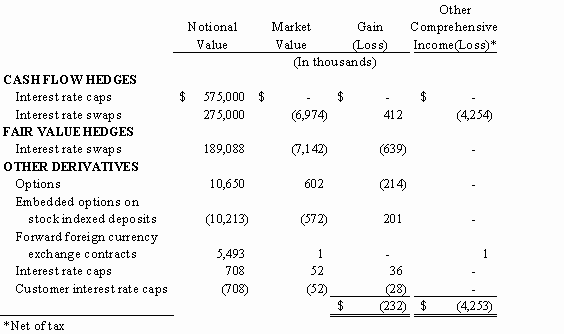
As of December 31, 2001, the Corporation had the following derivative financial instruments outstanding:

Interest rate caps are similar to option contracts that require the writer to pay the purchaser at specified future dates, the amount (if any) by which a specified market interest rate exceeds the fixed cap rate applied to a notional principal amount. The purchaser pays a premium for transferring the risk of unfavorable interest rate changes to the option writer. The Corporation´s principal objective in holding interest rate caps is the management of interest rate risk and to secure future cash flows, specifically to hedge the Corporation´s cost of funds, in the Commercial Paper Program and Repurchase Agreements, and to close the gap in a scenario of interest rates to the upside.
As of March 31, 2002, the Corporation had outstanding interest rate caps, with a notional value of $575,000,000, maturing through the year 2002. The caps are at a level of 6.50% against the one-month Libor. The premium paid on these transactions was approximately $27,746,000 and was being amortized on a monthly basis over the life of the caps until December 31, 2000. On January 1, 2001, pursuant to the implementation of SFAS No. 133, the Corporation recognized a transition adjustment loss on the write-off of the premium paid on caps of approximately $8,410,000 net of the effect of the related tax benefit of approximately $5,377,000 as a cumulative type adjustment in the consolidated statements of income. On that date, the Corporation also recorded a gain of approximately $1,190,000 net of the effect of the related tax cost of approximately $760,000 in other comprehensive income on the recognition of the intrinsic value of the caps derivative. As of March 31, 2002, the Corporation recognized no gain or loss related to that derivative.
Interest rate swaps involve the exchange of fixed and floating interest rate payments without an exchange of the underlying principal. Net interest settlements of interest rate swaps are recorded as an adjustment to interest income or interest expense of the hedged item.
The Corporation´s principal objective in holding interest rate swap agreements is the management of interest rate risk and changes in the fair value of assets and liabilities. The Corporation´s policy is that each swap contract be specifically tied to assets or liabilities with the objective of transforming the interest rate characteristic of the instrument. The Corporation swapped $100.0 million of term funds at a fixed spread over U.S. Treasury securities. These swaps were designated as cash flow hedges. The Corporation swapped $835.0 million during 2001and $40.0 million during 2002 to hedge the rollover of a series of fixed-rate short-term debt instruments. These swaps were designated as cash flow hedges. During 2002, $700 million of these cash flow hedges were cancelled due to the fact that the forecasted timing of rate increases did not occur within the time frame expected by management. A gain of $412,000 was recognized on the cancellation of these swaps.
As of March 31, 2002, the Corporation had outstanding interest rate swap agreements, with a notional amount of approximately $189,088,000, maturing through the year 2017. The weighted average rate paid and received on these contracts is 3.83% and 3.25%, respectively. As of March 31, 2002, the Corporation had retail certificates of deposit amounting to approximately $183.8 million swapped to create a floating rate source of funds and a $4.1 million variable rate loan were fixed at a spread over U.S. Treasury securities. These swaps were designated as fair value hedges. For the quarter ended March 31, 2002, the Corporation recognized a loss of approximately $639,000 on fair value hedges due to hedge ineffectiveness included in other gains and losses in the consolidated statements of income.
The Corporation issues certificates of deposit and IRA accounts with returns linked to the Standard and Poor´s 500 index which constitutes an embedded derivative instrument that must be bifurcated from the host deposit and recognized on the balance sheet in accordance with SFAS No. 133. The Corporation enters into option agreements in order to manage the interest rate risk on these deposits however, these options have not been designated for hedge accounting, therefore gains and losses on the market value of both the embedded derivative instruments and the option contracts are marked to market through earnings and recorded in other gains and losses on the consolidated statements of income. The Corporation recognized a transition adjustment gain of approximately $140,000 and a loss of approximately $174,000 on the embedded derivative instruments and the option contracts, respectively. For the quarter ended March 31, 2002, a gain of approximately $201,000 was recorded for the embedded derivative instr uments and a loss of approximately $214,000 was recorded on the option contracts.
Forwards are contracts for the delayed purchase of specified securities at a specified price and time. These contracts qualify for hedge accounting in accordance with SFAS No. 133. The Corporation occasionally enters into foreign currency exchange contracts in order to satisfy the needs of its customers, and at the same time enters into foreign currency exchange contracts with a related party under the same terms and conditions. As of March 31, 2002, the Corporation had foreign currency exchange contracts with a notional amount of $5,493,000 and recorded a gain of $1,455 net of the related tax liability of $568 in other comprehensive income (loss).
The Corporation occasionally enters into certain derivative with customers. During 2002 the Corporation entered into interest rate caps with customers and simultaneously hedged the cap with an interest rate cap with a related party under the same terms and conditions. The Corporation recognized a net gain of $8,000 on this transaction.
PART II – OTHER INFORMATION
ITEM I – LEGAL PROCEEDINGS
The Corporation is involved as plaintiff or defendant in a variety of routine litigation incidental to the normal course of business. Management believes, based on the opinion of legal counsel, that it has adequate defense or insurance protection with respect to such litigation and that any losses therefrom, whether or not insured, would not have a material adverse effect on the business or financial condition of the Corporation.
ITEM 2 – CHANGES IN SECURITIES |
| Not applicable |
ITEM 3 – DEFAULTS UPON SENIOR SECURITIES |
| Not applicable |
ITEM 4 – SUBMISSION OF MATTERS TO A VOTE OF SECURITY HOLDERS |
| Not applicable |
ITEM 5 – OTHER INFORMATION |
| Not applicable |
ITEM 6 – EXHIBITS AND REPORTS ON FORM 8-K | |
| | |
A.Exhibit No. | Exhibit Description | Reference |
| | |
(2.0) | Agreement and Plan of Merger-Banco Santander Puerto Rico and | |
| Santander Bancorp | a. |
(2.1) | Stock Purchase Agreement Santander BanCorp and Banco Santander | |
| Central Hispano, S.A. | b. |
(3.1) | Articles of Incorporation | c. |
(3.2) | Bylaws | d. |
(4.1) | Authoring and Enabling Resolutions 7% Noncumulative Perpetual | |
| Monthly Income Preferred Stock, Series A | e. |
(4.2) | Offering Circular for $25,000,000 AFICA Note Program | f. |
(4.3) | Bank Notes Program and Distribution Agreement | g. |
(4.4) | Offering Circular for $26,000,000 AFICA Note Program | h. |
(4.5) | Offering Circular for $25,000,000 AFICA Note Program | i. |
| | |
a. Incorporated by reference to Exhibit (2.0) of the 1999 Third Quarter Form 10Q | |
b. Incorporated by reference to Exhibit (2.1) of the 2000 10K | |
c. Incorporated by reference to Exhibit (3.1) of the 1998 form 10K | |
d. Incorporated by reference to Exhibit (3.2) of the 1998 form 10K | |
e. Incorporated by reference to Exhibit (4.1) of the 1998 form 10K | |
f. Incorporated by reference to Exhibit (10.1) of the 1999 Third Quarter Form 10Q | |
g. Incorporated by reference to Exhibit (10.2) of the 1999 Third Quarter Form 10Q | |
h. Incorporated by reference to Exhibit (4.4) of the 2000 10K | |
i. Incorporated by reference to Exhibit (4.5) of the 2001 10K | |
| | |
B. Reports on Form 8-k | |
None | | |
SIGNATURES
Pursuant to the requirements of Section 13 of the Securities Exchange Act of 1934, the Corporation has duly caused this report to be signed on its behalf by the undersigned thereunto duly authorized:
SANTANDER BANCORP |
Name of Corporation |
| | |
Date: May 10, 2002 | | By:/s/ José Ramón Gonzalez |
| | President Chief Operating Officer and |
| | Chief Financial Officer |
| | |
Date: May 10, 2002 | | By:/s/ María Calero |
| | Executive Vice President |
| | And Principal Accounting Officer |




 Contractual maturities on certain securities, including mortgage-backed securities could differ from actual maturities since certain issuers have the right to call or prepay these securities.
Contractual maturities on certain securities, including mortgage-backed securities could differ from actual maturities since certain issuers have the right to call or prepay these securities.
























